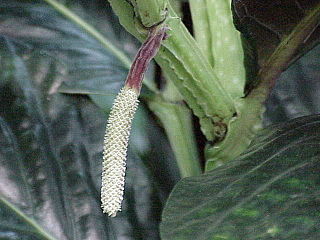
Piper, the pepper plants or pepper vines, is an economically and ecologically important genus in the family Piperaceae.

Zingiberaceae or the ginger family is a family of flowering plants made up of about 50 genera with a total of about 1600 known species of aromatic perennial herbs with creeping horizontal or tuberous rhizomes distributed throughout tropical Africa, Asia, and the Americas. Members of the family Zingiberaceae including turmeric, ginger, Javanese ginger, and galangal have been used for centuries in traditional medicine. Preclinical studies of Zingiberaceae extracts have shown analgesic properties.
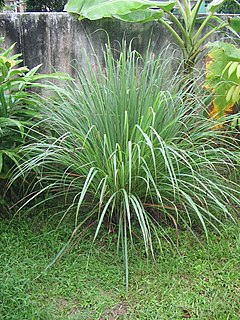
Cymbopogon, also known as lemongrass, barbed wire grass, silky heads, Cochin grass, Malabar grass, oily heads or fever grass, is a genus of Asian, African, Australian, and tropical island plants in the grass family. Some species are commonly cultivated as culinary and medicinal herbs because of their scent, resembling that of lemons . The name cymbopogon derives from the Greek words kymbe and pogon "which mean [that] in most species, the hairy spikelets project from boat-shaped spathes."
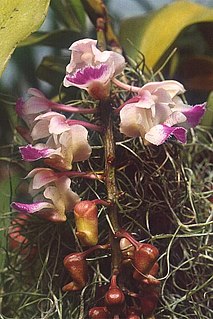
Aerides, known commonly as cat's-tail orchids and fox brush orchids, is a genus belonging to the orchid family. It is a group of tropical epiphyte orchids that grow mainly in the warm lowlands of tropical Asia from India to southern China to New Guinea. They are valued in horticulture for their racemes of showy, fragrant, colorful flowers.

Cryptocoryne is a genus of aquatic plants from the family Araceae. The genus is naturally distributed in tropical regions of India, Southeast Asia and New Guinea.

The Dipterocarpaceae are a family of 16 genera and about 695 known species of mainly tropical lowland rainforest trees. The family name, from the type genus Dipterocarpus, is derived from Greek and refers to the two-winged fruit. The largest genera are Shorea, Hopea, Dipterocarpus, and Vatica. Many are large forest-emergent species, typically reaching heights of 40–70 m, some even over 80 m, with the tallest known living specimen 93.0 m tall. The species of this family are of major importance in the timber trade. Their distribution is pantropical, from northern South America to Africa, the Seychelles, India, Indochina, Indonesia, Malaysia and Philippines. The greatest diversity of Dipterocarpaceae occurs in Borneo. Some species are now endangered as a result of overcutting, extensive illegal logging, and habitat conversion. They provide valuable woods, aromatic essential oils, balsam, and resins, and are a source for plywood.

Curcuma zedoaria is a perennial herb and member of the genus Curcuma, family Zingiberaceae. The plant is native to South Asia and Southeast Asia but is now naturalized in other places including the US state of Florida. Zedoary was one of the ancient food plants of the Austronesian peoples. They were spread during prehistoric times to the Pacific Islands and Madagascar during the Austronesian expansion. Its use as a spice in the West today is extremely rare, having been replaced by ginger, and to a lesser extent, yellow turmeric.

Olea is a genus of about 40 species in the family Oleaceae, native to warm temperate and tropical regions of the Middle East, southern Europe, Africa, southern Asia, and Australasia. They are evergreen trees and shrubs, with small, opposite, entire leaves. The fruit is a drupe. Leaves of Olea contain trichosclereids.

Tectona is a genus of tropical hardwood trees in the mint family, Lamiaceae. The three species are often collectively called teak.

Agrostistachys is a plant genus of the family Euphorbiaceae first described as a genus in 1850. It is native to Southeast Asia, New Guinea, India, and Sri Lanka.
- Agrostistachys borneensisBecc. - India, Sri Lanka, Thailand, Vietnam, Malaysia, Borneo, Philippines, Sumatra, New Guinea
- Agrostistachys gaudichaudiiMüll.Arg. - Thailand, Peninsular Malaysia
- Agrostistachys hookeri(Thwaites) Benth. & Hook.f. - Sri Lanka
- Agrostistachys indicaDalzell - India, Sri Lanka, Thailand, Vietnam, Myanmar, Laos, Cambodia, Malaysia, Borneo, Philippines, New Guinea
- Agrostistachys sessilifolia(Kurz) Pax & K.Hoffm. - Peninsular Malaysia, Borneo, Sumatra
- Agrostistachys staminodiataSevilla - Sumatra
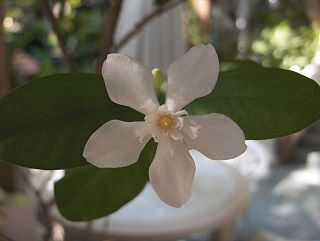
Wrightia is a genus of flowering plants in the family Apocynaceae, first described as a genus in 1810. It native to tropical Africa, China, the Indian Subcontinent, Southeast Asia, Papuasia, and Australia. The species are all small trees or shrubs.

Galeola is a genus of orchids belonging to the subfamily Vanilloideae.
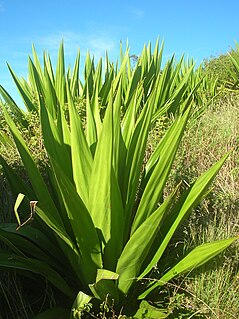
Furcraea is a genus of succulent plants belonging to the family Asparagaceae, native to tropical regions of Mexico, the Caribbean, Central America and northern South America. Some species are also naturalized in parts of Africa, the United States (Florida), Portugal, Thailand, India, and Australia, as well as on various oceanic islands. They are xerophytic monocots.

Barringtonia is a genus of flowering plants in the family Lecythidaceae first described as a genus with this name in 1775. It is native to Africa, southern Asia, Australia, and various islands of the Pacific and Indian Oceans. The genus name commemorates Daines Barrington.
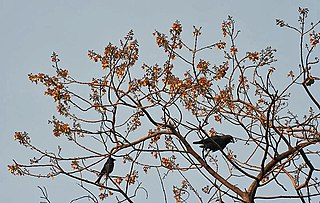
Gmelina is a genus of plants in the family Lamiaceae. It consists of about 35 species in Australia, New Guinea, New Caledonia, Southeast Asia, India and a few in Africa. Some species such as G. arborea have been planted and/or become naturalised in India, Africa and Australia. It was named by Carl Linnaeus in honour of botanist Johann Georg Gmelin.

Kaempferia is a genus of plants in the ginger family. It is native to China, India, and Southeast Asia.

Nechamandra is a monotypic genus of an aquatic plant family Hydrocharitaceae. The sole species is Nechamandra alternifolia. It is found in slow moving fresh water.
Clarkella is a monotypic genus of flowering plants in the family Rubiaceae. The genus contains only one species, viz. Clarkella nana, which is native to India, China, Uttarakhand, the Western Himalayas, Burma and Thailand.

Platostoma is a genus of flowering plants in the mint family, Lamiaceae, first described as a genus in 1818. It is native to tropical parts of Africa, southern Asia, Papuasia, and Australia. Mesona and Acrocephalus has been known as its synonyms.
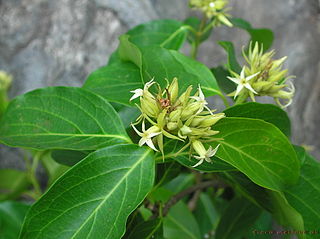
Aganosma is a genus of plants in family Apocynaceae first described as a genus in 1837. It is native to China, the Indian Subcontinent, and Southeast Asia.
- Aganosma brevilobaKerr - Guizhou, Myanmar, Thailand
- Aganosma cymosa(Roxb.) G.Don - Guangxi, Yunnan, Bangladesh, Assam, Sri Lanka, Indochina
- Aganosma gracilisHook.f. - Assam, Bhutan, Arunachal Pradesh
- Aganosma heynei(Spreng.) ined. - India
- Aganosma laceiRaizada - Myanmar
- Aganosma petelotiiLý - N Vietnam
- Aganosma schlechterianaH.Lév. - S China, Assam, N Indochina
- Aganosma siamensisCraib - Thailand, Vietnam, Guangxi, Guizhou, Yunnan
- Aganosma wallichiiG.Don - Myanmar, Thailand, W Malaysia, Java, Sumatra



















